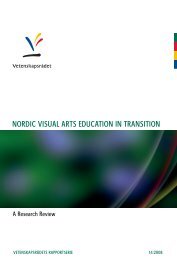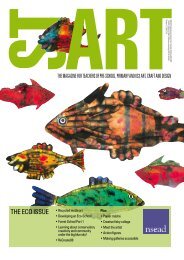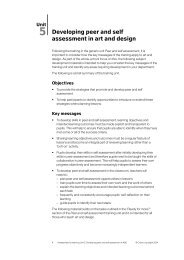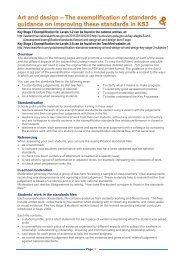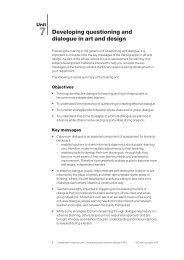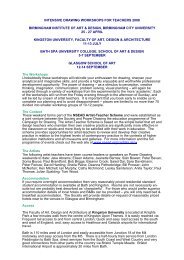Download PDF - The National Society for Education in Art and Design
Download PDF - The National Society for Education in Art and Design
Download PDF - The National Society for Education in Art and Design
Create successful ePaper yourself
Turn your PDF publications into a flip-book with our unique Google optimized e-Paper software.
May be l<strong>in</strong>ked to the follow<strong>in</strong>g KS1 & 2<br />
units <strong>for</strong> the QCA Scheme of Work:<br />
Investigat<strong>in</strong>g Materials, Investigat<strong>in</strong>g Pattern,<br />
Talk<strong>in</strong>g Textiles, Journeys.<br />
Further <strong>in</strong><strong>for</strong>mation:<br />
www.art<strong>for</strong>schools.com<br />
05<br />
START<br />
SIMPLY<br />
TO DYE FOR<br />
Tim Ma<strong>in</strong>stone <strong>in</strong>troduces a<br />
tie-dye technique from the<br />
African Yoruba peoples <strong>in</strong> the<br />
first of a series of multicultural<br />
classroom resources.<br />
A resist tie-dye technique is used to<br />
produce the complicated patterns of the<br />
Adire cloth. Adire means ‘to take, to tie,<br />
to dye’ <strong>and</strong> is similar to the common<br />
batik process that uses wax as the resist<br />
medium except that, traditionally,<br />
cassava starch is used <strong>in</strong>stead.<br />
<strong>The</strong> design is pa<strong>in</strong>ted on a white cotton<br />
cloth with cassava starch, us<strong>in</strong>g a chicken<br />
feather as the brush. <strong>The</strong> cloth is then<br />
dried <strong>and</strong> the starch scraped off.<br />
In another method the cloth is folded,<br />
knotted or stitched so that those parts<br />
protected from the dye rema<strong>in</strong>ed white.<br />
<strong>The</strong> numerous patterns <strong>and</strong> designs on<br />
Adire cloth have symbolic mean<strong>in</strong>gs <strong>and</strong><br />
make reference to animals <strong>and</strong> plants from<br />
the local environment. <strong>The</strong> pattern used<br />
<strong>for</strong> this piece is ‘Ibad<strong>and</strong>un,’ which means<br />
‘Ibadan is a happy place.’ <strong>The</strong> cities of<br />
Ibadan <strong>and</strong> Abeokuta were the traditional<br />
centres of textile design <strong>and</strong> were famous<br />
<strong>for</strong> their <strong>in</strong>digo blue <strong>and</strong> white Adire cloth.<br />
Where it comes from<br />
Centuries ago great empires, k<strong>in</strong>gdoms<br />
<strong>and</strong> small family-centred chiefdoms<br />
flourished throughout Africa. Ghana, Mali,<br />
Songhai <strong>and</strong> Kanem-Borno were great<br />
trad<strong>in</strong>g empires located <strong>in</strong> north-central<br />
Africa <strong>in</strong> a region known as the Sudan.<br />
<strong>The</strong>se powerful <strong>and</strong> wealthy k<strong>in</strong>gdoms<br />
were well known to European <strong>and</strong> Arab<br />
traders who crossed the Sahara Desert<br />
with their caravans of products dest<strong>in</strong>ed<br />
<strong>for</strong> Marrakech <strong>in</strong> north-west Africa <strong>and</strong><br />
the ancient cities of Timbuktu <strong>and</strong> Gao.<br />
At different times <strong>in</strong> history, one or another<br />
of these empires controlled the trans-<br />
Saharan trade routes as well as the routes<br />
to the k<strong>in</strong>gdoms of the Congo, Ben<strong>in</strong> <strong>and</strong><br />
the Yoruba <strong>in</strong> sub-Saharan Africa.<br />
By 800 AD the Yoruba speak<strong>in</strong>g<br />
<strong>in</strong>habitants of what is now Nigeria had<br />
created a number of highly urbanised<br />
city-states or k<strong>in</strong>gdoms. <strong>The</strong>y left an<br />
impressive array of objects that help to<br />
document the rich <strong>and</strong> complex history<br />
of the Yoruba speak<strong>in</strong>g peoples from<br />
800 AD to the present.<br />
Objects made be<strong>for</strong>e the twentieth century<br />
carry no dates <strong>and</strong> the identities of the<br />
<strong>in</strong>dividual artisans are rarely known. <strong>The</strong><br />
purpose <strong>and</strong> style of the artefact, whether<br />
it was a mask <strong>for</strong> <strong>in</strong>itiation <strong>in</strong>to a secret<br />
society or a staff or tray used dur<strong>in</strong>g<br />
rituals, rarely changed from generation to<br />
generation. Members of religious <strong>and</strong><br />
secret societies (<strong>in</strong>stitutions responsible<br />
<strong>for</strong> ma<strong>in</strong>ta<strong>in</strong><strong>in</strong>g control <strong>and</strong> social order)<br />
commissioned these objects. <strong>The</strong>ir<br />
presence rem<strong>in</strong>ded the people of the<br />
importance of their customs, traditions<br />
<strong>and</strong> past history. In the n<strong>in</strong>eteenth century<br />
European <strong>and</strong> American traders, explorers,<br />
<strong>and</strong> missionaries carried many artefacts<br />
such as masks, jewellery, drums, weaponry<br />
<strong>and</strong> textiles out of Africa. <strong>The</strong>y thought of<br />
these objects as ‘curiosities’ <strong>and</strong> often<br />
displayed them <strong>in</strong> their homes. Eventually<br />
many of these objects were collected by<br />
museums <strong>and</strong> <strong>for</strong>med the basis of African<br />
or primitive art collections.<br />
How to use the Adire cloth<br />
<strong>in</strong> the classroom<br />
1. Have a discussion about the Adire cloth.<br />
How do you th<strong>in</strong>k the cloth was made?<br />
Who do you th<strong>in</strong>k made it? How old is it?<br />
What patterns, shapes <strong>and</strong> symbols have<br />
been used? Were different shades of blue<br />
used <strong>in</strong> the dye<strong>in</strong>g process? What was<br />
used to create the different patterns?<br />
Which parts of the cloth were covered <strong>in</strong><br />
starch? How can you tell? Do you th<strong>in</strong>k the<br />
shapes <strong>and</strong> patterns have hidden mean<strong>in</strong>gs,<br />
if so what do they refer to? Do you like the<br />
Adire Cloth?<br />
What do you like/dislike about it? Would<br />
you like to wear clothes made from<br />
Adire cloth? If you had to wear an article<br />
of cloth<strong>in</strong>g made from Adire cloth, what<br />
would it be?<br />
2. Apply a rectangle of thick blue pa<strong>in</strong>t<br />
(chromar – Berol) to a sheet of A4 paper.<br />
Us<strong>in</strong>g a variety of different implements<br />
(plastic cutlery, lollipop sticks, old biros,<br />
combs) scratch shapes <strong>in</strong>to the pa<strong>in</strong>t <strong>and</strong><br />
create your own Adire pattern. Ask the<br />
children to th<strong>in</strong>k about the designs <strong>and</strong><br />
symbols they use <strong>for</strong> their sheet. <strong>The</strong>se<br />
could refer to, or give clues about, the<br />
environment <strong>in</strong> which they live. <strong>The</strong><br />
completed designs could be placed<br />
together on a board, or wall, to create a<br />
huge class Adire design.<br />
3. Split the class <strong>in</strong>to small groups <strong>and</strong> ask<br />
them to design a treasure map based on<br />
Adire symbols.<br />
4. You are a famous detective <strong>and</strong> have<br />
been asked to unravel the mystery of the<br />
famous Adire Cloth. Can you decipher<br />
the mean<strong>in</strong>g of the cloth <strong>and</strong> tell its story...<br />
a story which has eluded the greatest<br />
m<strong>in</strong>ds throughout history?<br />
5. <strong>Design</strong> a piece of cloth<strong>in</strong>g us<strong>in</strong>g the<br />
traditional Adire method of either tie-dye<br />
or starch paste (use flour <strong>and</strong> water).<br />
Create patterns <strong>in</strong> the starch us<strong>in</strong>g feathers<br />
<strong>and</strong> dye the piece with an <strong>in</strong>digo blue dye.<br />
6. Discuss the type of clothes that we<br />
wear <strong>for</strong> special occasions. Ask the class<br />
to br<strong>in</strong>g <strong>in</strong>, <strong>and</strong> compare different types of<br />
cloth<strong>in</strong>g. What similarities <strong>and</strong> differences<br />
are there <strong>in</strong> the design/function/com<strong>for</strong>t of<br />
the cloth<strong>in</strong>g? How important are logos?<br />
Are who made the clothes more important<br />
than how com<strong>for</strong>table they are? Look at<br />
<strong>and</strong> compare cloth<strong>in</strong>g worn <strong>in</strong> different<br />
countries (or at different times <strong>in</strong> history).<br />
How does climate <strong>in</strong>fluence what we wear?<br />
THE NEW MAGAZINE FOR PRIMARY AND PRE-SCHOOL TEACHERS OF ART, CRAFT & DESIGN





